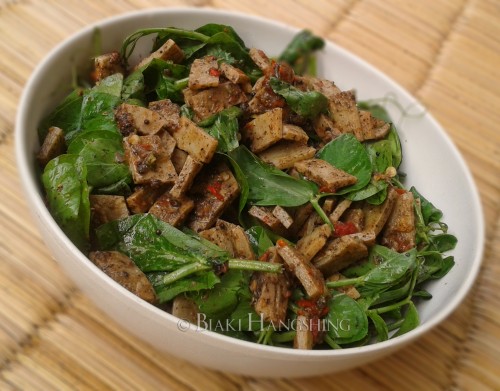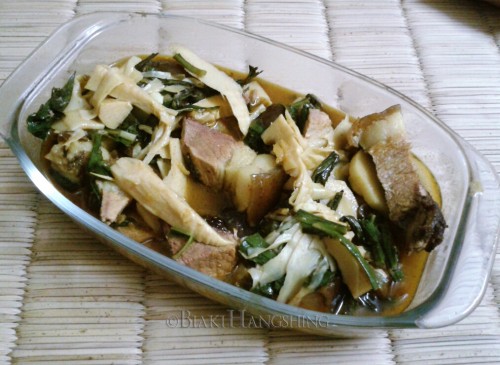ZOMI CUISINES by Biaki Hangshing
August 1, 2013– as captured by Sanzeeta
North-East India is a lesser known region in food map of India, especially when foods are from interior states like Mizoram, Nagaland, Meghalaya, Manipur and Arunachal Pradesh. Cuisines from these states have remained invisible as table menus, although few ethnic food outlets have come up sporadically in metros with an attempt to define food habits of a particular tribe. North-east Indian states have their own special way of cooking – made in perfect wilderness using indigenous herbs and greens rich in nutrients which are limited mostly for local use. This issue of Fried Eye, our special guest, Biaki Hanshing, from Manipur, a state in North – East India, introduces Zomi (pronounced ‘Zou’- ‘me’) cuisines to our readers. Biaki brings a unique taste, identity and real flavour that belong to her culture. For her, cooking is pure joy and soul-filling. It is very rare to find such perfect combination of indigenous ingredients and food presentation with such appetising colours as her’s. Fried Eye thanks Biaki Hanshing for providing information on such treasured recipes. Hope our readers have a wonderful exposure to a basket of gemmed cuisines from Manipur.
Q: How would you describe Zomi food?
Biaki: ‘What passes as “Zomi food” in mainland India or elsewhere can be a far cry from the meals that people in Zogam enjoy. To begin with, the Zomis, like the rest of their neighbours in the northeast, are good eaters and have elaborate varieties of authentic foods. Rice is fundamental and wild sticky rice is their special. Their authentic foods compulsorily have four courses to start with. The significant part is that the courses were served simultaneously not like modern day-five star traditions. The four compulsory courses are:
- Steaming platter of steamed rice called ‘buhsih’.
- Chutney, made entirely of hot fresh chillies burned and grinned to paste with fermented animal fats called ‘sathu’ to create a pungent aroma,
Biaki Hangshing
- Boiled various green vegetables for peculiar, bland, hot, aromatic, healthy and fleshy plain gravy called ‘antuimawl’ taken to stream down the food particles and to help in digestion besides healing the thirst;
- The main curry prepared with rice and dry/fresh meat over charcoal fire exuding peculiar flavor by adding some drops of distilled fresh-ash water called ‘ta-ngal’ into it, totally avoiding use of oil and spices, that may include braising, finally produces totally authentic curry called ‘mehpok’ served at the centre of the round plate.
Zomi cuisine avoids those very items that define Indian food – oil and spices, but begin to made inroad in a big way to mainland India for its taste and healthy preparations.’
Q: Biaki, would you say something about you, as a cook. How did you learn to prepare such rich ethnic dishes?
Biaki: ‘Hey everyone! My name is Biaki and I am a big foodie. I do not have any formal training but am very passionate about cooking, especially experimenting with new and different recipe combinations. My interest in food begins at an early age. When I was a little child, I would watch my mom turn simple vegetables into delicious dish, which always amazed me.’
Q: In what way Zomi dishes are different?
Biaki: ‘Traditionally we use very less amount of oil in the food; we either boil, steam or roast our foods. The distinctive taste of our food comes from the little amount of fermented products that we add to the food. These products include Bekanthu (fermented soybean), Sathu (fermented fats), Ngari (fermented fish), Ankamthu (fermented mustard leaves) and Ta-ngal (Distilled fresh-ash water).’
Q: How cooking inspired you?
Biaki: ‘I went to Delhi for education and studied at CSKM, Kirori Mal and NIIT. During these days, I was exposed to different kinds of food and different ways of cooking. It was during this period when I actually started to cook. I would try to replicate the dishes mom used to make with some modifications, depending on the ingredients available at hand. The appreciation from friends and family encourages me further in trying out newer recipes. I would like to mention here that Vir Sanghvi, the print and media journalist had used a picture of one of my pork dish in his article “Rude Food: Living high off the hog”
Q: Could you share some Zomi recipes which you treasure the most?
Biaki: Here are some traditional hill foods of Manipur with recipes. Do try it out and you will be surprise how good you can actually turn out a dish. You can also check out my facebook page “Biaki’s Kitchen”. The real taste of the food comes from the effort you put in and how passionate you are about your cooking. I try to be intuitive instead of strictly following a given set of instructions so that the food turn out just the way I like.
RECIPE – 1
Meh Pok
Ingredients:
- Sihzou (local name) 20 g
- Dried meat (250g)
- Singzual( local name) 20g
- Rice(30-50g)
- Salt
- Soda or Distilled fresh-ash water called ‘ta-ngal’
Method:
Boil the sihzou, dried meat and rice in a pot with about 1.5 litres of water. It’s better to bring the flame down as should not dry up too soon. This slow boiling continues till the rice become very soft and starts breaking up and the meat becomes tender. Now add a teaspoon of ta-ngal (or a pinch of soda) and stir continuously for about 7 mins. Add Singzual, salt to taste, and the dish is ready when the gravy begins to turn thick.
RECIPE – 2
Zawngtah Malta Meh (Chutney)
Ingredients:
- Zawngtah(parkia roxburghii) 3-4 Pods
- Pea tendrils(50g)
- King chilli(2 small/1big)
- Fermented fish(2-3pieces)
- Salt
- Perilla seeds(30 g)
Method:
First the green cover of 3-4 zawngtah is scrapped off and the sides of the bean is trimmed as well. Now cut the bean in-between the seed. Boil water and put the cut pieces into the boiling water and allow the water to boil for another minute and drain the water.
Wash the pea tendrils in cold water and drain the water.
Roast the king chilly and fermented fish.
Grind them adding salt to taste. Now mix all the above in a bowl and add the roasted and coarsely ground perilla seeds to the mixture. Hot and tasty Malta Meh is ready.
RECIPE – 3
Meh Al/Meh Bai (Mixed Vegetables)
Ingredients:
- Mushroom(dried / fresh) 50g
- Frenchbeans (50g)
- Bean leaves(10-15g)
- Green chilli( 5-6)
- Lengmasel (Elsholtzia blanda)
- Smoked fish(250g)
- Salt to taste
Method:
Boil the smoked fish in a litre of water and add mushroom, beans, bean leaf, green chilli and salt. When the vegetables appear done, then add lengmasel, turn off the flame after boiling for another 5 mins.
RECIPE – 4
Antuimawl
Ingredients:
- Khangkhuh (acacia pennata) (50g)
- Brinjal (250g)
- Anphuiteh (Clerodendrum colebrookianum)(50g)
Method:
Clean all the above vegetables. Boil brinjal in about a litre of water. When the brinjal changes colour add anphuiche and continue to boil. After about 7-8 minutes add khangkhuh and allow the cooking to continue for another7-8 minutes and turn off the flame. Here salt, chilli or any kind of spices is not added.
RECIPE – 5
Voksahou toh Gotuai
(Smoked Pork with bamboo shoot)
Ingredients:
- Smoked Pork – (500g)(clean and keep aside)
- Bamboo shoot (fresh/fermented. Fresh bamboo shoot requires pressure cooked for 4/5 whistles and drain water)( 250g)
- Garlic(9-10cloves),Ginger (50g),Onion (1 big) – make paste
- Salt to taste
- Culantro (20 leaves)
Method:
Roast the pork in a non-stick pan till it becomes brown and oil comes out of it.
Add ginger-garlic-onion paste, stir well and put to low flame. Stir once in a while.
After about 30 mins add the bamboo shoot, salt and a little water
Cover and cooked in low flame till meat is tender. Finally add culantro leaves, boil for 7/10 mins. It’s ready to be served.









I always love our tribal dishes. Good for the stomach and best fit for health. Tried Japanese, Indian, Thai, Singapore dishes, The KFC and Mc Donalds but Zomi cuisines is beyond compare
Hiai d khawng eihtuh..zoumi i hih na… Hoihlua hon sunzom tou zeel aw..
doesnt look like much but sure as hell taste like heaven. @biakiHangsing has got some pretty insane recipes. kudos!!